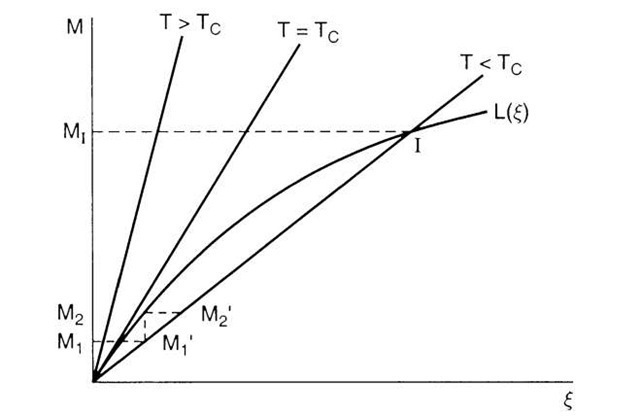Molecular Field Theory
So far, we implied that the magnetic field, which tries to align the magnetic moments, stems from an external source only. This assumption seems to be not always correct. Weiss observed that some materials obey a somewhat modified Curie law, as shown in Fig. 15.3(b) and (c). He postulated, therefore, that the magnetic moments of the individual electrons (or atoms) interact with each other. In this case, the total magnetic field, Ht, acting on a magnetic moment, is thought to be composed of two parts, namely, the external field, He, and the molecular field, Hm,
where
contains the molecular field constant, g. The susceptibility is calculated by using (15.30), (15.32), and (15.33)
Solving (15.34) for M yields
Finally, we obtain
which is the experimentally observed Curie-Weiss law (15.2). If 9 is found to be positive, then the interactions of the individual magnetic moments reinforce each other, i.e., the magnetic moments align parallel. In this case the susceptibility becomes larger, as can be deduced from (15.36).
We now attempt to interpret ferromagnetism by making use of the molecular field theory. We already know from Section 15.1.3 that, in ferromagnetic materials, the neighboring magnetic moments interact with each other, which leads to a spontaneous magnetization in small domains below TC. Weiss postulated that the above-introduced internal or molecular field is responsible for this parallel alignment of spins, and considered ferromagnetics to be essentially paramagnetics having a very large molecular field. In essence, he applied the Langevin theory to ferromagnetics. In the light of quantum theory, the molecular field is essentially the exchange force, as we shall see in Section 16.2.
We follow the train of thought put forward by Weiss. Let us consider the case for no external magnetic field. Then the spins are only subjected to the molecular field Hm. This yields for the Langevin variable Z (see (15.22)), with (15.33),
and provides for the magnetization by rearranging (15.37):
We note from (15.38) that for the present case the magnetization is a linear function of Z with the temperature as a proportionality factor (see Fig. 15.18).
Figure 15.18. Langevin function L(Z), i.e., (15.28) and plot of (15.38) for three temperatures.
The intersection I of a given temperature line with the Langevin function L(Z) represents the finite spontaneous magnetization, M7, at this temperature.3 With increasing temperature, the straight lines in Fig. 15.18 increase in slope, thus decreasing the point of intercept, I, and therefore the value for the spontaneous magnetization. Finally, at the Curie temperature, TC, no intercept, i.e., no spontaneous magnetization, is present anymore. The slope![]() in (15.38) is then identical to the slope of the Langevin function near the origin, which is
in (15.38) is then identical to the slope of the Langevin function near the origin, which is![]() according to (15.29) and (14.8). This yields, for TC,
according to (15.29) and (14.8). This yields, for TC,
A value for the molecular field constant, g, can then be calculated by measuring the Curie temperature and inserting TC into the rearranged equation (15.39):
This yields, for the molecular magnetic field strength (15.33),
Numerical values for the molecular field are around 109 A/m (107 Oe) (see Problem 10). This hypothetical field is several orders of magnitude larger than any steady magnetic field that can be produced in a laboratory. We should note that even though the molecular field theory gives some explanation of ferromagnetism, it cannot predict which solids are ferromagnetic. Quantum theory extends considerably our understanding of this matter.
We mention in closing that the molecular field theory can also be applied to antiferromagnetics and to ferrimagnetic materials. As we know from Section 15.1.4, we need to consider in this case two interpenetrating sub-lattices, A and B, each having mutually antiparallel aligned spins. This means that we now have to consider a molecular field, HmA, acting on the A ions which stems from the magnetization. MB, of the B ions. Since the magnetization of A and B ions point in opposite directions, the molecular field from an adjacent ion is now negative. The calculations, which follow similar lines as shown above, yield equation (15.4), i.e., the Curie-Weiss law for antiferromagnetics.
![tmp8-404_thumb[2][2] tmp8-404_thumb[2][2]](http://what-when-how.com/wp-content/uploads/2011/07/tmp8404_thumb22_thumb.jpg)
![tmp8-405_thumb[2][2] tmp8-405_thumb[2][2]](http://what-when-how.com/wp-content/uploads/2011/07/tmp8405_thumb22_thumb.jpg)
![tmp8-406_thumb[2][2] tmp8-406_thumb[2][2]](http://what-when-how.com/wp-content/uploads/2011/07/tmp8406_thumb22_thumb.jpg)
![tmp8-407_thumb[2][2] tmp8-407_thumb[2][2]](http://what-when-how.com/wp-content/uploads/2011/07/tmp8407_thumb22_thumb.jpg)
![tmp8-408_thumb[2][2] tmp8-408_thumb[2][2]](http://what-when-how.com/wp-content/uploads/2011/07/tmp8408_thumb22_thumb.jpg)
![tmp8-409_thumb[2][2] tmp8-409_thumb[2][2]](http://what-when-how.com/wp-content/uploads/2011/07/tmp8409_thumb22_thumb.jpg)

![tmp8-415_thumb[2][2] tmp8-415_thumb[2][2]](http://what-when-how.com/wp-content/uploads/2011/07/tmp8415_thumb22_thumb.jpg)
![tmp8-418_thumb[2][2] tmp8-418_thumb[2][2]](http://what-when-how.com/wp-content/uploads/2011/07/tmp8418_thumb22_thumb.jpg)
![tmp8-419_thumb[2][2] tmp8-419_thumb[2][2]](http://what-when-how.com/wp-content/uploads/2011/07/tmp8419_thumb22_thumb.jpg)
